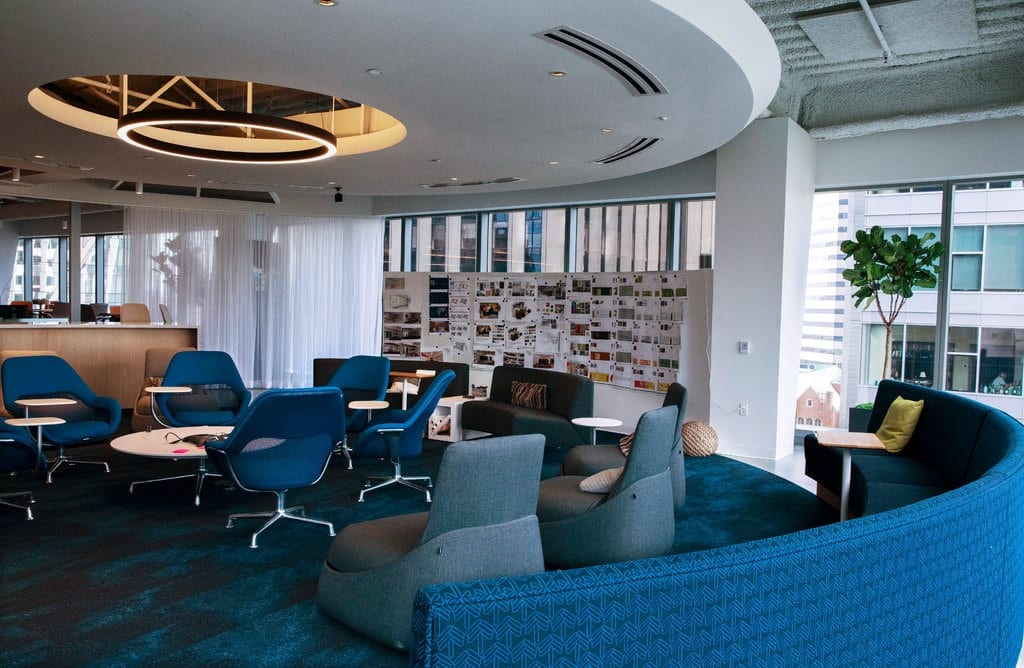What will workplaces look like after COVID-19?
Automatic doors, easy-to-clean surfaces, and distanced desks are just some of the changes we could see in our offices. But will the changes end there?
The New York Times recently revealed what the future of offices could look like. As a result of COVID-19, there’s a clear need for spacious and hygiene-friendly offices.
However, the immediate need for social distancing and hygiene practises are only a small part of our changing needs. As our Decade of Courage Manifesto outlines, there’s a growing demand for a different way of work.
The benefits of remote working have been significantly amplified during the pandemic. As over half of UK workers feel more productive working from home, it’s safe to assume that many companies will extend remote work. Social media giant Facebook is planning to permanently embrace remote working after the pandemic – and it’s likely that many companies will follow suit.
And with smaller budgets and a heightened environmental awareness, it’s not surprising that many businesses aren’t planning to head back to the office after COVID-19.
What will COVID-secure offices look like?
In the immediate reality, there will be physical changes to offices as we know them now. Hand sanitation stations, empty seats between colleagues, and protective screens are just some of the changes you could expect to see.

[Source nytimes.com]
These small but significant changes will have a domino effect on the way we interact and work with one another. As our Decade of Courage Manifesto outlines, the need for greater digital collaboration will be more pressing than ever. With face-to-face meetings vetoed and social distancing in place, many decisions will be made online – even whilst you’re in the office.
The future of workplaces after COVID-19
While we can guess how our offices could adapt today, it’s less clear how our office space will evolve beyond the pandemic. Ultimately, the need for a complete digital transformation will become clear within every business. From HR processes to project management, each and every business practise needs to take place in the digital realm.
But what lies between the physical office and a completely digital workplace? We take a look…
Will hot-desking be safe during COVID-19?
By definition, hot-desking is a system which allows workers to rent desks in a shared office space – and it’s hugely popular with many industries. For remote workers, it can be a way to touch base without paying over the odds for a permanent office.
However, the risks of hot-desking after COVID-19 are clear. According to government guidelines, hot-desking should be avoided in order to lower the risk of spreading the virus. The combination of revolving workers and shared spaces, unsurprisingly, creates a perfect breeding ground for viruses.
But will hot-desking ever recover after the pandemic? Aside from the virus, hot-desking isn’t always the perfect solution for remote workers. In fact, research has shown that hot-desking can lead to distrust amongst workers, a lack of morale, and fewer office friendships.
As productivity has soared whilst we’ve worked from home, the demand for hot desks could plummet. And with tighter budgets and our renewed appreciation for remote working, it seems likely that hot-desking could turn cold in the near future.
Bringing the office closer to home
Smaller, local hubs could replace large, centralised office buildings. As Barclays’ CEO Jes Stanley has said: “The notion of putting 7,000 people in a building may be a thing of the past.”
While COVID-19 is still in general circulation, managing a large, centralised office could become a logistical nightmare. As local outbreaks are likely to spike, the consequences of a company-wide flare-up could be huge – not to mention costly.
Smaller ‘cluster’ type offices could provide a much safer alternative. Dividing your workforce into small pods closer to where clusters of colleagues live could spark a new way of work: safer, environmentally-friendly, and more efficient.
Beyond the pandemic, localised pods could also breathe life into our high streets. As funding is largely poured into main cities, occupying local areas and unused buildings could help decentralise government investment. And reducing commute times for your employees can only have a positive effect, too.
Are physical offices always necessary?
In the past, we’ve placed a disproportionate level of importance on physical workplaces. COVID-19 has shown us that a lack of shared space doesn’t always reduce morale – in fact, it can boost connection between colleagues.
As Corteva CEO Jim Collins says: “I have been so much more connected to 20,000 employees in the last six weeks than in the past six months, thanks to the technology we are using.”
Cultivating team connections can occur outside a typical, centralised workplace. By significantly slashing your office budget, you can afford to enjoy plenty of team building and social events.
Ultimately, with the right technology in place, a completely digital workplace can promote effective connection and collaboration amongst employees. Not only that, but it can help strengthen your business in the event of a future pandemic or outbreak.
Discover the new way of working inside our Decade of Courage Manifesto. From office alternatives to efficient decision making, we can help you navigate these uncertain times.
Take the next step…
Categorised in: Future of work, Remote working during COVID-19

